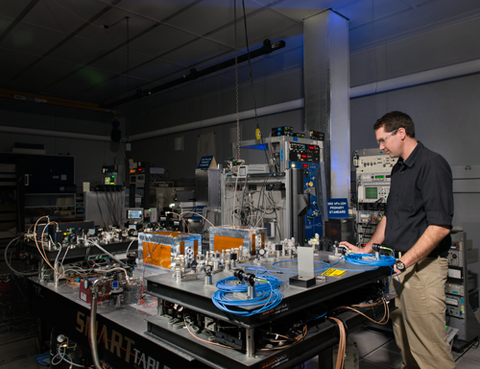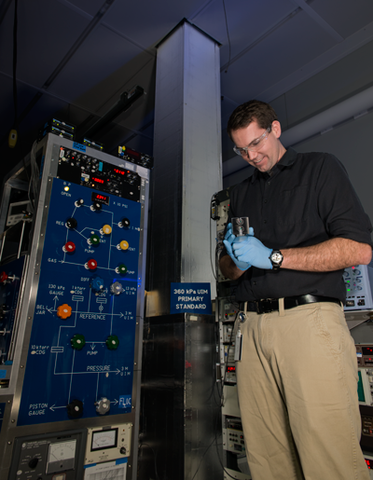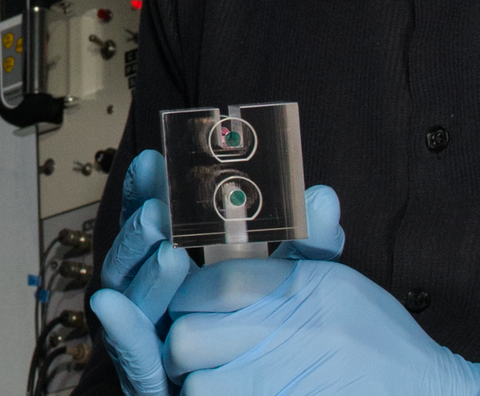
PML's Jacob Ricker with the two FLOCs (copper boxes, center) and the mercury manometer (blue column, right).
When a team of researchers at NIST's Physical Measurement Laboratory (PML) first tested a new kind of pressure sensor two years ago, initial results showed it was faster and had higher resolution than the traditional, centuries-old mercury-based method for measuring pressure. The novel device, called the Fixed Length Optical Cavity (FLOC), works by detecting subtle changes in the frequency of light passing through a nitrogen gas-filled cavity about the size of a box of tissues.
Now the same research team has thoroughly vetted the FLOC against the U.S. mercury-based pressure standard, currently a world leader in pressure measurement. Their verdict: The photonic sensor performs better than expected and, in fact, outperforms the traditional mercury system at low pressure ranges. The work was carried out jointly by a team of NIST scientists from PML's Sensor Science Division and Engineering Physics Division.
"This is the biggest fundamental change to pressure measurement since the invention of the mercury manometer in 1643," says Jay Hendricks, PML's Thermodynamic Metrology Group Leader. "This breakthrough will enable development of smaller and smaller standards and possibly chip-scale primary pressure standards in the future. Additionally, this technique can cover up to nine decades of pressure, a task that currently requires six different primary standards."
Until now, the most reliable way to measure pressure has used a technique invented almost 400 years ago, involving a column of mercury whose height changes with pressure. But this type of device – called a manometer – is relatively slow, taking about a minute per measurement. It's also bulky. The current U.S. primary pressure standard is a mercury manometer 3 meters (about 10 feet) tall, that extends through the ceiling of the laboratory in which it is housed. Furthermore, manometers typically require mercury,* a toxin whose use is currently being phased out of products and manufacturing internationally.
The FLOC, by contrast, is mercury-free and consists of a chamber approximately 15.5 cm (about 6 inches) long by 5 cm (about 2 inches) square, a fraction of the size of the U.S. standard manometer. The device works by comparing the changes in optical path length between a pair of mirrors attached to two separate channels, one in vacuum and the other filled with ultra high-purity nitrogen gas.
"The length of each channel is measured by tuning the frequency of a laser so that a standing wave is set up between the mirrors," says PML's Jacob Ricker. Ricker explains that when gas is pumped into the nitrogen channel (i.e. as the gas pressure increases), it takes the light a longer time to bounce between the mirrors. So the effect they measure is the same as if the channel were being physically lengthened. (Changes in pressure do physically distort the channels slightly, but the researchers have measured and characterized this source of noise so they know what to expect.) The property of gas that changes the speed of light is known as the material's index of refraction.

With a change of pressure in the gas-filled channel, the frequency of the laser light bouncing around in that channel must change, too, in order to maintain a standing wave. The team has designed their system to compare this frequency change to the frequency of light in the vacuum channel, which remains the same. Measuring the changing frequency of the light in the gas-filled channel allows researchers to determine the gas' index of refraction, a quantity that lets them work out the pressure. (For more information about how the FLOC works, see "World's First Photonic Pressure Sensor Outshines Traditional Mercury Standard.")
To vet the new instruments' performance, Ricker hooked a FLOC and the manometer up to the same pressure source. But he couldn't flood both devices with the same sample of pressurized gas, because the FLOC relies on the ultra high-purity of their nitrogen gas for its accuracy. Instead, he connected the systems using a capacitance diaphragm gauge (CDG), a device that measures the difference between two pressures.
The head-to-head comparison and analyses show that the smaller, faster FLOC – each measurement takes less than a second to perform – is more precise than the manometer at pressures below about 1 kilopascal (kPa, approximately 0.15 pounds per square inch).
Alas, pitting the newcomer against the reigning champion of pressure measurements still amounts to a "he said, she said," without additional checks in place. So the researchers built a second FLOC and tested all three instruments against each other.
They discovered that the FLOCs gave the same results to within about 1 part per million, while the disagreement between the manometer and either FLOC was up to twelve times worse. Furthermore, both FLOCs had a reproducibility and linearity of just 1 part per million at all pressures between 100 Pa and 100,000 Pa. (Linearity here means that the ratio of input to output is about the same at any pressure within that range.) And because both FLOCs were linear, the team was able to attribute the disagreement to nonlinearities in the manometer.
One reason for their excellent agreement? "We baked the FLOCs for two months at 373 K (100 degrees C) in a vacuum," says PML's Patrick Egan. "Heating helps speed up the curing process for the bonding** that was used to attach mirrors to the ends of each channel. Since the measurement of pressure in the FLOC comes from the measurement of length between the mirrors, it is very important that the mirrors are attached to the channels with high stability."

After this heat curing, the researchers saw a relative drift between the pair of mirrors on each channel of about 6 femtometers (million billionths of a meter) per hour – a tiny amount. "That's smaller than the nucleus of a gold atom," Egan says.
Although the team has beaten the manometer's accuracy at low pressures, their analysis reveals that, for measurements at pressures above 1 kPa, the FLOC is two times less accurate than the manometer. But that's not surprising, Egan says, since the FLOC's measurement of pressure depends on how accurately researchers can calculate the refractive index of nitrogen. And ironically, that calculation is limited by how accurately researchers can measure nitrogen's pressure with the best instrument they currently have: the mercury manometer.
So a long-term goal of the group is to create a new device to help them further shrink the FLOC's uncertainties.
"To do that, we have to measure the refractive index of nitrogen better than anything that's been done before," Egan says. "And that's what we're working on now."***
The immediate next phase however, Egan says, is to use the FLOCs alongside the manometer to calibrate customers' pressure gauges this summer. "That will be the first step on a road which departs from the three-and-a-half-century-old measurement tradition," he says.
— Reported and written by Jennifer Lauren Lee
* There is currently a global push to cut or phase out use of mercury in products and manufacturing. See the United Nations Environment Programme's (UNEP) activities on mercury. (link removed; no longer active.)
** For more information about the bonding procedure, see "A Thin, Strong Bond for Vacuum Seal."
*** The FLOC is designed to be a workhorse pressure standard that uses the properties of nitrogen gas for accuracy. To make the FLOC more accurate than the manometer, the PML team must measure the refractive index of nitrogen at a pressure that is known more accurately than the mercury manometer can currently provide. To get this information, the team is building a device called the variable-length optical cavity (VLOC), a cousin of the FLOC that will employ helium gas instead of nitrogen. By using the much more complicated but potentially more accurate VLOC to gauge the pressure of nitrogen gas, the team will have the information it needs to push their FLOCs to outperform the mercury manometer at higher pressures.

